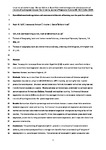Quantified moorland vegetation and assessment of the role of burning over the past five millennia
| dc.contributor.author | Fyfe, R | |
| dc.contributor.author | Ombashi, H | |
| dc.contributor.author | Davies, HJ | |
| dc.contributor.author | Head, Katie | |
| dc.date.accessioned | 2018-03-13T13:21:56Z | |
| dc.date.issued | 2018-05 | |
| dc.identifier.issn | 1100-9233 | |
| dc.identifier.issn | 1654-1103 | |
| dc.identifier.uri | http://hdl.handle.net/10026.1/11084 | |
| dc.description.abstract |
© 2017 International Association for Vegetation Science. Aims: To apply the Landscape Reconstruction Algorithm (LRA) to pollen count data from multiple sites to estimate local vegetation abundance and compare with charcoal-derived records of burning. Location: Exmoor, southwest England, UK. Methods: Pollen count data from 16 sites were transformed to estimates of distance-weighted vegetation abundance using the LRA (REVEALS and LOVE models), correcting for bias in pollen production and dispersal. Charcoal concentration data from six sites were normalized using Box-Cox transformation to produce z-scores. Moving-window correlation was undertaken to compare pollen percentage values for key taxa (Calluna, Poaceae) and localized burning. Estimates of distance-vegetation abundance (LRA output) and time-averaged charcoal z-scores were compared to assess the role of burning as a driver for upland vegetation cover. Results: Comparison of pollen percentage and normalized charcoal z-scores show little correlation between vegetation cover and burning. Estimates of distance-weighted vegetation abundance and normalized charcoal data show relationships between vegetation change and burning at four of the six sites. The relationships are site-specific: three sites suggest burning promoted grass-dominated vegetation, at one site burning promoted heather-dominated vegetation, and in two sites there is no apparent relationship. Conclusions: The patterning of vegetation within uplands is a crucial part of ecosystem service delivery, and contemporary and future management benefits from understanding of 'long-term' development, i.e. patterns over millennia. The correction of biases within pollen production and dispersal to produce local vegetation estimates has demonstrated spatial heterogeneity in vegetation cover on Exmoor that is not otherwise evident in the pollen percentage data (which retain a strong influence of the regional vegetation cover). The relationship between LRA-derived vegetation cover and burning is not apparent in comparisons between pollen percentage data and charcoal records. This implies that studies that use pollen proportional data alone can misrepresent the relationship between vegetation cover and fire. This study demonstrates that fire has been an important part of the development of this cultural landscape. | |
| dc.format.extent | 393-403 | |
| dc.format.medium | Undetermined | |
| dc.language | en | |
| dc.language.iso | en | |
| dc.publisher | Wiley | |
| dc.subject | Calluna | |
| dc.subject | charcoal | |
| dc.subject | exmoor | |
| dc.subject | holocene | |
| dc.subject | landscape reconstruction algorithm | |
| dc.subject | LOVE | |
| dc.subject | pollen | |
| dc.subject | REVEALS | |
| dc.title | Quantified moorland vegetation and assessment of the role of burning over the past five millennia | |
| dc.type | journal-article | |
| dc.type | Journal Article | |
| plymouth.author-url | https://www.webofscience.com/api/gateway?GWVersion=2&SrcApp=PARTNER_APP&SrcAuth=LinksAMR&KeyUT=WOS:000438651900005&DestLinkType=FullRecord&DestApp=ALL_WOS&UsrCustomerID=11bb513d99f797142bcfeffcc58ea008 | |
| plymouth.issue | 3 | |
| plymouth.volume | 29 | |
| plymouth.publication-status | Accepted | |
| plymouth.journal | Journal of Vegetation Science | |
| dc.identifier.doi | 10.1111/jvs.12594 | |
| plymouth.organisational-group | /Plymouth | |
| plymouth.organisational-group | /Plymouth/Admin Group - REF | |
| plymouth.organisational-group | /Plymouth/Admin Group - REF/REF Admin Group - FoSE | |
| plymouth.organisational-group | /Plymouth/Faculty of Science and Engineering | |
| plymouth.organisational-group | /Plymouth/Faculty of Science and Engineering/School of Geography, Earth and Environmental Sciences | |
| plymouth.organisational-group | /Plymouth/REF 2021 Researchers by UoA | |
| plymouth.organisational-group | /Plymouth/REF 2021 Researchers by UoA/UoA14 Geography and Environmental Studies | |
| plymouth.organisational-group | /Plymouth/Research Groups | |
| plymouth.organisational-group | /Plymouth/Research Groups/Marine Institute | |
| plymouth.organisational-group | /Plymouth/Users by role | |
| plymouth.organisational-group | /Plymouth/Users by role/Academics | |
| dcterms.dateAccepted | 2017-11-15 | |
| dc.rights.embargodate | 2018-12-1 | |
| dc.identifier.eissn | 1654-1103 | |
| dc.rights.embargoperiod | Not known | |
| rioxxterms.version | Accepted Manuscript | |
| rioxxterms.versionofrecord | 10.1111/jvs.12594 | |
| rioxxterms.licenseref.uri | http://www.rioxx.net/licenses/all-rights-reserved | |
| rioxxterms.licenseref.startdate | 2018-05 | |
| rioxxterms.type | Journal Article/Review |


